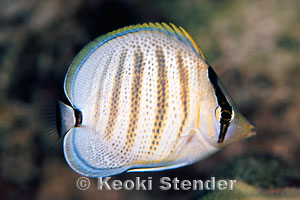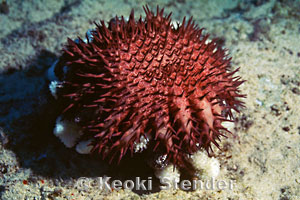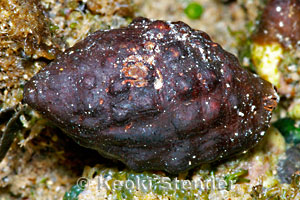 |
| Coral fragment adorned with snails. Photo M. Heckman |
   |
| Coral eating Phystilla seaslug, Multiband butterflyfish and Crown-of-thorns seastar - Photos by M. Heckman and K.Stender |
 |
| Violet coral-eating snail, Coralliophila violacea. Photo K. Landers |
These animals are part of the Murex snail group which includes our familiar drupe snails and muricid snails. The group in general are predators, often on animals with shells. For instance, the common granular drupe, Morula granulata or maka 'awa that you can find on rocks all along the Hawaiian intertidal, drills a hole into barnacles, limpets or other shelled animals that can't run away, then slurps out the insides. The drilling is undoubtedly a bit of work, but provides a good end result (for the drupe).
 |
| Granular drupe. Image K. Stender |
The violet snail's prey, coral, does not require any drilling. In a coral (unlike a barnacle) the tissue comes first, then the skeleton. The violet snail can simply insert it's proboscis into the coral tissue and sip, siphon or suck - depending on how you feel about these animals taking a meal from the coral.
| C. violacea next to its feeding scar. Photo K. Landers |
So, theoretically, if a snail has moderate needs it can stay in one place and just gently feed without killing the host, a time honored parasitic lifestyle. However, this does not always work out; the Caribbean version of the violet coral snail, the abbreviated coral snail (Coralliophila abbreviata), creates larger and larger denuded areas as it feeds on elkhorn corals, leading to significant tissue loss. With Caribbean and Atlantic coral reefs in such poor shape, any population of abbreviated coral eating snails is not looked upon with favor. The host corals are already dying from a variety of causes and the more aggresive coral eating snail is not helping the situation.
| Violet coral snail on P. compressa fragment. Photo K.Landers |
Other interesting facts about these snails:
 |
| Photo K.Landers |
Secondly, rather than laying the eggs out in the open, the female broods her eggs under the edge of her shell until they hatch. Most mollusks do not show such parental care, they just lay their eggs about in ribbons or patches and then crawl off to let the eggs hatch on their own.
Finally, while other snails within the violet coral snail family, Coralliophilidae, live on corals, some live in the coral. One type bores into the skeleton of mushroom corals, making a burrow so tight it cannot even turn around.
If you see one of these snails in the wild, just admire it. Unless it is doing obvious damage, it is just part of the system.
Aloha,
Mark
References for this article and on these snails tend to be a bit scarce or technical, but if you have time are very interesting.
For info on the drupe snail feeding, John Hoover's Hawai'i's Sea Creatures always recommended.
For Hawaiian snails and shells in general, the slightly dated but still excellent, Hawaiian Marine Shells: Reef and Shore Fauna of Hawaii, Section 4: Mollusca.Alison Kay. 1979. Honolulu: B.P. Bishop Museum Press. Look for a used copy.
Image of abbreviated coral snail damage (and another Caribbean Coralliophila that causes much less damage) can be found at this site: Field Guide to Western Atlantic Coral Diseases and Other Causes of Coral Mortality.
Image of Coralliophila on a Red Sea coral, see the Living Oceans Foundation's, " The hungry hungry corallivores" blog post.
Other selected references (accessed 07/12/12)
Ecology of a corallivorous gastropod, Coralliophila abbreviata, on two scleractinian hosts. II. Feeding, respiration and growth. I. B. Baums, M. W. Miller and A. M. Szmant. Marine Biology Volume 142, Number 6 (2003), 1093-1101, DOI: 10.1007/s00227-003-1053-4
Population connectivity of the corallivorous gastropod Coralliophila abbreviata: larval dispersal potential and genetic structure. L Johnston, AW Bruckner. 2010. pdf - data.nodc.noaa.gov.
Host effect on size structure and timing of sex change in the coral-inhabiting snail Coralliophila violacea. Ming-Hui Chen, Keryea Soong and Min-Li Tsai. Marine Biology Volume 144, Number 2 (2004), Pages 287-293
Prudent sessile feeding by the corallivore snail, Coralliophila violacea on coral energy sinks. U. Oren, I. Brickner, and Y. Loya. Proc Biol Sci. 1998 November 7; 265(1410): 2043–2050.
accessed from http://www.ncbi.nlm.nih.gov/pmc/articles/PMC1689502/

No comments:
Post a Comment